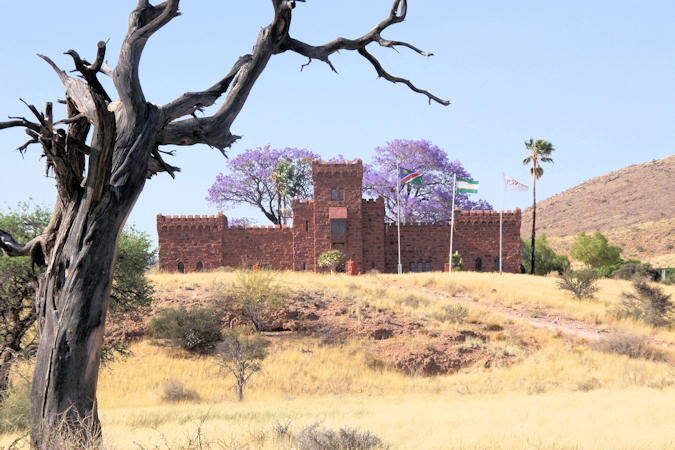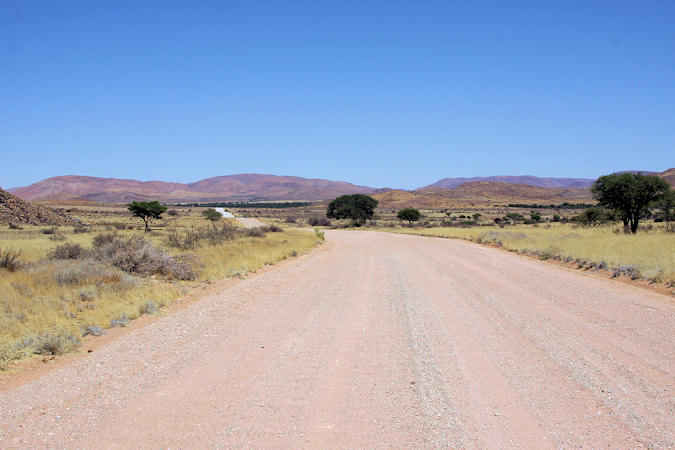Namibia
Things to DO
Vioolsdrif
 |
|||||
Vioolsdrif is a village on the Orange River and the main crossing point for Namibia-Cape traffic.
The name in Afrikaans means "the ford (shallow river crossing) of the violin". It is reportedly named after Jan Viool
("John Violin"), who is said to have played the fiddle in these parts in the nineteenth century.
Some say he was a Nama man, who used to guide ox-wagons across the ford. An accomplished player, he would fiddle away merrily on the
river bank while waiting for wagons to arrive.
Vioolsdrif has several campsites and motels for motorists passing through the border.
In general, the surrounding region is almost unpopulated. There are small pockets of fertile alluvial soil along the course of the river
and these are used for growing crops, such as dates and melons, under irrigation.
With the presence of permanent water, expect to see several kingfishers among the birds, including the tiny but beautiful Malachite.
Look out, too, for the locally common Orange River White-eye - aptly named for its white eye-ring.
Fish River Canyon
 |
|||||
The Fish River Canyon is the largest canyon in Africa and is certainly one of Africa's least-visited wonders.
It features a gigantic ravine, in total about 161 km long, up to 27 km wide and in places almost 550 meters deep.
The Fish River is the longest interior river in Namibia. It cuts deep into the plateau which is today dry, stony and sparsely covered
with hardy drought-resistant plants. The river flows intermittently, usually flooding in late summer; the rest of the year it becomes a
chain of long narrow pools.
The area around the southern part of Fish River Canyon was proclaimed a conservation area in 1969. The land was as poor in potential for
agriculture as it is rich in potential for tourism and this was a way of protection the area from uncontrolled development.
Vegetation is sparse. Both on top and on the canyon's slopes, the larger species are mostly euphorbias, with the odd Quiver Tree and
occasional deep red aloe.
Driving around you will probably see few larger animals, though there are many if you look hard. These include herds of Hartman's Mountain
Zebra, small goups of kudu and the smaller klipspringer antelope, which are usually seen in pairs.
Lüderitz
 |
|||||
The bay on which Lüderitz is situated was first known to Europeans when Bartolomeu Dias encountered it in 1487. He named the bay
Angra Pequena (Portuguese: "Small Bay") and erected a "padrão" (stone cross) on the southern peninsula.
Further exploration expeditions followed in the early 19th century during which the vast wildlife in the ocean was discovered. Profitable
enterprises were set up, including whaling, seal hunting, fishing and guano-harvesting. Lüderitz thus began its life as a trading post.
The town was founded in 1883 when Heinrich Vogelsang purchased Angra Pequena and some of the surrounding land on behalf of Adolf
Lüderitz, from the local Nama chief Josef Frederiks II.
In 1909, after the discovery of diamonds nearby, Lüderitz enjoyed a sudden surge of prosperity due to the development of a diamond rush to
the area.
After the German World War I capitulation South Africa took over the administration of German South West Africa in 1915. Many Germans were
deported from Lüderitz, contributing to its shrinking in population numbers.
 |
|||||
The Sperrgebiet is a diamond mining area in southwestern Namibia.
It spans the Atlantic Ocean-facing the coast from Oranjemund on the border with South Africa, to around 72 kilometres north of Lüderitz, a
distance of 320 km north.
However, mining only takes place within a few kilometers of the coast, a coastal belt 100 km wide was declared "out of bounds" as
a precaution to prevent unauthorised people from reaching the diamond fields.
The Sperrgebiet was designated as a national park in June 2004.
There are several ghost towns in the Sperrgebiet, built in the late 19th century.
Pomona itself once housed over a thoasand people, of whom some 300-400 were German and the rest black Namibian workers, these later
living in huts that accommodated up to 50 people.
At Bogenfels a small desalination plant is still to be seen right on the beach. The main atraction for visitors, though, is a
spectacular rock arch that stands about 55 m high beside the sea.
Where it has been untouched by diamond mining, much of the environment is prestine with 234 plants being endemic to southwest Namibia
Malthahöhe
 |
|||||
Standing solidly admidst the rolling hills about 72 km southwest of Maltahöhe, the sandstone fortress of Duwisib Castle is another
of those anachronisms in which Namibia seems to specialise. Look from a distance and you won't believe it; a small, square castle with
fortified battlements anf high turrets in the middle of the African bush.
The castle was built in 1908 by Hansheinrich von Wolf a Saxon artillery officer who served with the Royal Saxon Artillery near
Dresden. He came to South West Africa as a captain in the Schutztruppe, when he volunteered after the outbrak of the Herero War.
Von Wolf bought eight farms in the Maltahöhe area covering 20.000 hectares, to which they added another 35.000 hectares in 1910, operating
the property as a stud farm for English and Australian thoroughbred horses.
What are said to be descendants of their horses can be seen today roaming free and wild as Namib Desert Horses near Garub along the
roadside in the restricted diamond areas, although whether this is the origin of these herds is not accurately known.
Sesriem
 |
|||||
Sesriem is a small settlement and the main access point to the Namib-Naukluft National Park.
Covering almost 50.000 km2, this park is one of the largest national parks in Afrika, protecting one of the oldest deserts on Earth.
The Nabib desert's scenery is stunning and its wildlife fascinating; you just need to make the time to stop and observe.
It’s easy to explore the contrasting landscapes by yourself. The roads are spectacular, so make sure you leave plenty of time to stop,
take photographs and have a picnic surrounded by space and silence.
An hour’s drive northeast of Sesriem, the main escarpment juts out into the desert forming a range known as the Naukluft Mountains.
Receiving occasional heavy rainstorms in summer that feed its network of springs and streams in its deeper kloofs, the Naukluft supports
a surprisingly varied flora and fauna.
The Naukluft has many animals, including large mammals, though all are elusive and difficult to spot. Most common are ground squirrel,
springbok, warthog and ostrich.
 |
|||||
About 4km from Sesriem, is Sesriem Canyon. This is a narrow fissure in the sandstone, 30m deep in places, carved by the
Tsauchab River.
It was used by the early settlers, who drew water from it by knotting together six lengths of hide rope (called riems). Hence
it became known as "ses riems".
The road from Sesriem to Sossusvlei is soon confined into a corridor, flanked by huge dunes. Gradually, this narrows,
becoming a few kilometres wide. This unique parting of the southern Namib’s great sand sea has probably been maintained over the millennia
by the action of the Tsauchab River and the wind.
Tsauchab River, that flow westward, but never reach the ocean. It ends by forming flat white pans dotted with green trees, surrounded
by spectacular dunes – islands of life within a sea of sand.
Dead Vlei is an old pan with merely the skeletons of trees left – some over 500 years old.
 |
|||||
Solitaire, about 70 km northeast of Sesriem, is a large dot on the map, but is just a few buildings, run by the helpful, if
idiosyncratic, Moose.
Yet it is so atmosheric, so typical of a middle-of-nowhere stop in the desert, that it's been the location for several film and advert
scenes.
There is a fuel station here that is pretty reliable and it is still the best place for miles to have puncures mended.
Shopping here, with the wooden counters, old-fashioned weighting scales and jars of sweet, feels like stepping back in time
The Namib Carnivore Conservation Centre offers a truly unique cheetah tracking safari where you can accompany a wildlife biologist
into our enormous 500ha "soft-release"' enclosure in search of these cats. The drive guaranties up-close encounters with cheetah
and a fascinating insight into the research methods used by the NCCC